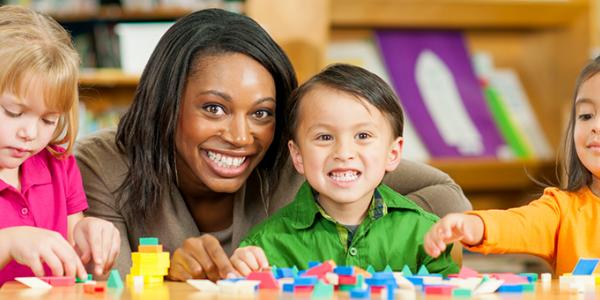Preparing Young Children for the Inclusion of Children with Disabilities into the Classroom

In the past decade, preschool classrooms have become more inclusive, including children with a wide range of abilities. In fact, an article by Odom (2000) showed that in the late 1990s, nearly 70 percent of private early education centers included children with disabilities. More recently, data suggests that for children in kindergarten or above, five percent of children attend private school settings (National Center for Education Statistics, 2017).
Inclusive preschool classrooms are in the best interest of all young children: including children with disabilities results in greater empathy and acceptance of differences among all children and in improved academic, social, and behavioral outcomes for children with disabilities.
Despite its benefits, inclusion still poses many challenges for teachers. Children with disabilities may exhibit a variety of behaviors that differ from those of their peers, including avoiding eye and physical contact, preferring to play alone, inappropriate facial expressions, delays in communication or an inability to communicate verbally, aggressive tendencies, a lack of attention or focus, limited mobility, and an inability to complete self-help tasks (such as dressing or using the toilet).
Here are some tips for making your classroom more inclusive and helping all students be successful!
- Be sure that your classroom is physically accessible for all students. Remove any barriers that might prevent a child getting from one place to another.
- Position children with disabilities in the midst of their peers; do not place the child in a wheelchair at the edge of the group or the student with aggressive tendencies away from his peers.
- Encourage children without disabilities to interact with children who do have disabilities.
- Promote authentic friendships—children without physical impairments sometimes take on a “parent” role in interactions with their peers with disabilities.
- Help children find common ground and ways to interact with one another as friends.
- Give all children tools for interactions and conversations. Provide them with toys or objects to initiate the discussion (an example might include a popular book).
- Provide children who struggle with communication with alternate ways to express themselves. This could involve pointing or using pictures.
- Pair children with and without disabilities to work and play together.
- Use a variety of methods for instruction—talk to your students, illustrate with pictures, model, and provide the opportunity for hands-on learning whenever possible.
- Provide a visual classroom schedule so that all children know the plan for the day.
- Explain a child’s disability to other children in the classroom. Allow them to ask questions about differences.
- Provide developmentally appropriate activities in the classroom that meet the learning, behavioral, and social needs of all children.
- When necessary, assist children with self-help skills, but expect them to help themselves whenever possible.
- Communicate frequently with parents and other early childhood professionals in your school.
- Treat all children in your classroom with love and respect.
- Have high expectations for all children, regardless of their ability levels.
- Seek out resources for learning more about teaching all types of learners, for example, Early Childhood Technical Assistance Center (http://ectacenter.org/) and the Technical Assistance Center on Social Emotional Intervention for Young Children (http://challengingbehavior.fmhi.usf.edu/).
NAEYC Resources
The Essentials: Supporting Young Children with Disabilities in the Classroom
Understanding and implementing inclusion starts here. Educators looking for a simple, straightforward introduction to the core concepts of teaching and supporting children with disabilities alongside their peers will want to have this resource at their fingertips.
Buy the Book!
Planning for an Inclusive Classroom: Supporting Children with Disabilities
When teachers open their classroom doors this new school year, they’ll be welcoming students with a variety of experiences, strengths, and challenges. A few children in your new class might have disabilities or developmental delays that impact their learning, social skills, or behavior. Watch this webinar to uncover how to best understand and implement inclusionary practices into the classroom that will help children with developmental delays or disabilities participate successfully alongside their peers.
Other Resources
DEC (Division for Early Childhood of the Council for Exceptional Children) & NAEYC (National Association for the Education of Young Children). 2009. “Early Childhood Inclusion.” Position statement. Missoula, MT: DEC; Washington, DC: NAEYC. www.naeyc.org/files/naeyc/file/positions/DEC_NAEYC_EC_updatedKS.pdf.
Downing, J.E., & K.D. Peckham-Hardin. 2007. “Inclusive Education: What Makes It a Good Education for Students with Moderate to Severe Disabilities?” Research and Practice for Persons with Severe Disabilities 32 (1): 16–30.
Essa, E.L., P.R. Bennett, M.M. Burnham, S.S. Martin, A. Bingham, & K. Allred. 2008. “Do Variables Associated with Quality Child Care Programs Predict the Inclusion of Children with Disabilities?” Topics in Early Childhood Special Education 28 (3): 171–80.
References
National Center for Education Statistics. 2017. "Children and Youth with Disabilities". https://nces.ed.gov/programs/coe/indicator_cgg.asp.
Odom, S.L. 2000. “Preschool Inclusion: What We Know and Where We Go from Here.” Topics in Early Childhood Special Education 20 (1): 20–7.
Marla Lohmann is Assistant Professor, Special Education at Colorado Christian University.